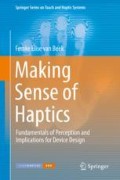Abstract
In teleoperation systems, damping is often injected to guarantee system stability during contact with hard objects. In this study, we used psychophysical experiments to assess the effect of adding damping on the user’s perception of object hardness. In Experiments 1 and 2, combinations of stiffness and damping were tested to assess their effect on perceived hardness. In both experiments, two tasks were used: an in-contact task, starting at the object’s surface, and a contact-transition task, including a free-air movement. In Experiment 3, the difference between global damping (present throughout the environment) and local damping (present inside the object only) was tested. In all experiments, force and position data were recorded to assess which parameters correlated with the participant’s perceptual decision. Experiments 1 and 2 show that with added damping, perceived hardness increased for an in-contact task, while it decreased for a contact-transition task, with the latter effect being much larger than the former. Experiment 3 shows that this effect was mainly due to the addition of global damping, since there was a large perceptual difference between adding global and local damping. The force and position parameters show that object indentation, mean velocity and adjusted rate-hardness correlated most strongly with the participant’s perceptual experience.
Access this chapter
Tax calculation will be finalised at checkout
Purchases are for personal use only
References
Bergmann Tiest WM (2010) Tactual perception of material properties. Vis Res 50(24):2775–2782
Bergmann Tiest WM, Kappers AML (2009) Cues for haptic perception of compliance. IEEE Trans Haptic 2(4):189–199
Blair GWS, Coppen FMV (1939) The subjective judgment of the elastic and plastic properties of soft bodies; the “differential thresholds” for viscosities and compression moduli. Proc R Soc Lond Ser B Biol Sci 128(850):109–125
Coppen F (1942) The differential threshold for the subjective judgement of the elastic and plastic properties of soft bodies. Br J Psychol Gen Sect 32(3):231–247
Coren S (1993) The left-hander syndrome. Vintage Books, New York
Han G, Choi S (2010) Extended rate-hardness: a measure for perceived hardness. In: Kappers AML, van Erp JBF, Bergmann Tiest WM, van der Helm FCT (eds) Haptics: generating and perceiving tangible sensations. Lecture notes in computer science, vol 6191. Springer, Berlin/Heidelberg, pp 117–124
Harper R, Stevens SS (1964) Subjective hardness of compliant materials. Q J Exp Psychol 16(3):204–215
Hokayem PF, Spong MW (2006) Bilateral teleoperation: an historical survey. Automatica 42:2035–2057
Jones LA, Hunter IW (1990) A perceptual analysis of stiffness. Exp Brain Res 79(1):150–156
Kuchenbecker K, Fiene J, Niemeyer G (2006) Improving contact realism through event-based haptic feedback. IEEE Trans Vis Comput Graph 12(2):219–230
Lawrence D (1993) Stability and transparency in bilateral teleoperation. IEEE Trans Robot Autom 9(5):624–637
Lawrence D, Pao LY, Dougherty A, Salada M, Pavlou Y (2000) Rate-hardness: a new performance metric for haptic interfaces. IEEE Trans Robot Autom 16(4):357–371
Nuño E, Basañez L, Ortega R, Spong MW (2009) Position tracking for non-linear teleoperators with variable time delay. Int J Robot Res 28:895–910
Nuño E, Basañez L, Ortega R (2011) Passivity-based control for bilateral teleoperation: a tutorial. Automatica 47:485–495
Rosenberg L, Adelstein B (1993) Perceptual decomposition of virtual haptic surfaces. In: Proceedings of the IEEE symposium on research frontiers in virtual reality, San Jose, pp 46–53
Sarkar N, Yun X (1996) Design of a continuous controller for contact transition task based on impulsive constraint analysis. In: Proceedings of the 1996 IEEE international conference on robotics and automation, vol 3, pp 2000–2005
Sheridan T (1993) Space teleoperation through time delay: review and prognosis. IEEE Trans Robot Autom 9(5):592–606
Srinivasan MA, LaMotte RH (1995) Tactual discrimination of softness. J Neurophysiol 73(1):88–101
Sun D, Naghdy F, Du H (2014) Application of wave-variable control to bilateral teleoperation systems: a survey. Annu Rev Control 38:12–31
Van der Linde R, Lammertse P (2003) HapticMaster – a generic force controlled robot for human interaction. Ind Robot Int J 30(6):515–524
Van Beek FE, Heck DJF, Nijmeijer H, Bergmann Tiest WM, Kappers AML (2015) The effect of damping on the perception of hardness. In: Proceedings of the IEEE world haptics conference (WHC), Evanston, pp 82–87
Author information
Authors and Affiliations
Rights and permissions
Copyright information
© 2017 Springer International Publishing AG
About this chapter
Cite this chapter
van Beek, F.E. (2017). The Effect of Damping on the Perception of Hardness. In: Making Sense of Haptics. Springer Series on Touch and Haptic Systems. Springer, Cham. https://doi.org/10.1007/978-3-319-69920-2_6
Download citation
DOI: https://doi.org/10.1007/978-3-319-69920-2_6
Published:
Publisher Name: Springer, Cham
Print ISBN: 978-3-319-69919-6
Online ISBN: 978-3-319-69920-2
eBook Packages: Computer ScienceComputer Science (R0)

